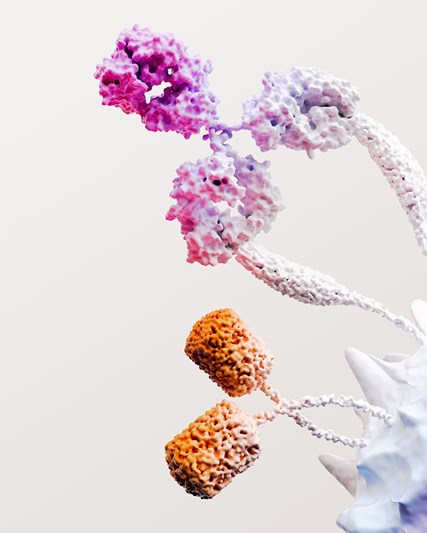Issued: London, UK
For media and investors only
GSK presents scientific advances to improve patient outcomes at the American Association for the Study of Liver Diseases’ The Liver Meeting® 2023
- New data from the B-Together phase IIb trial assessing the potential of a sequential treatment regimen of bepirovirsen followed by pegylated interferon alpha reflect contribution to the development of a functional cure for people living with chronic hepatitis B (CHB)
GSK plc (LSE/NYSE: GSK) will present 14 abstracts at the American Association for the Study of Liver Diseases’ (AASLD) The Liver Meeting® 2023, taking place in Boston, MA from 10-14 November. Presentations feature data from two novel investigational specialty medicines, bepirovirsen, an antisense oligonucleotide (ASO) for chronic hepatitis B (CHB), and linerixibat, an ileal bile acid transporter (IBAT) inhibitor for cholestatic pruritus in primary biliary cholangitis (PBC). Key data include the first oral presentation of full results from the B-Together phase IIb trial investigating bepirovirsen followed by pegylated interferon alfa (Peg-IFN) as treatment for people with CHB on nucleos(t)ide analogue therapy.
Chris Corsico, SVP, Development, GSK said: “We’re looking forward to highlighting research in a variety of serious liver conditions, stemming from our expertise in infectious disease, immunology and human genetics. Our presentations include new data for bepirovirsen which not only further our understanding of its durability of response and role as a future backbone of chronic hepatitis B treatment, but also improve our understanding of the heterogeneous nature of hepatitis B infections. These data across chronic liver diseases demonstrate our enduring commitment to ultimately improve patient care.”
Advancing the science for bepirovirsen, being investigated as the backbone of treatment regimens for people with CHB
The B-Together phase IIb trial assessed the potential for bepirovirsen followed by Peg-IFN as a sequential regimen to treat CHB infection, reduce hepatitis B surface antigen (HBsAg), and lower virus (HBV) DNA in the blood. The primary endpoint was the proportion of patients with HBsAg and HBV DNA below the lower limit of quantification (LLOQ) for 24 weeks after planned end of sequential treatment, in the absence of newly initiated antiviral therapy (rescue therapy). All patients that met the primary endpoint had a baseline surface antigen ≤3000 IU/mL, reinforcing the previously announced results from the B-Clear phase IIb trial which showed that treatment with bepirovirsen resulted in sustained clearance of HBsAg and HBV DNA both in patients on concurrent nucleoside/nucleotide analogues (NA) and patients not-on-NA therapy. The findings from the B-Together trial contribute to the goal of a functional cure for people living with CHB, as we apply important insights to additional treatment approaches to match the right therapy to appropriate patients.
Raising awareness of the impact of cholestatic pruritus on quality of life for people living with PBC
Data highlight the impact of pruritus, a debilitating itch related to the release of bile acids through the body, in people living with PBC as well as the need to urgently identify, and better manage, itch. Further data describe how, in patients with PBC and itch, reductions in serum biomarkers are associated with a clinical response to linerixibat.
GSK’s presentations at the American Association for the Study of Liver Diseases’ (AASLD) The Liver Meeting® 2023 include:
|
Asset |
Abstract Title |
Presenter |
Presentation Details |
|---|---|---|---|
|
Bepirovirsen |
Pegylated interferon reduces relapses following bepirovirsen treatment in participants with chronic hepatitis B virus infection on nucleos(t)ide analogues: end of study results from the Phase 2b B-Together study |
Maria Buti |
Oral (42723/ 49) |
|
Initial exploration of hepatitis B surface antigen (HBsAg) blips following bepirovirsen treatment: a post hoc analysis of the B-Clear study |
Seng-Gee Lim |
Poster (43837/ 1475-C) |
|
|
Mechanistic PK/PD modelling and simulation of bepirovirsen, HbsAg, and ALT after sequential |
Amir Youssef |
Poster (43871/ 1478-C) |
|
|
Protein expression associated with alanine aminotransferase increase during bepirovirsen treatment: analysis of the B-Clear study |
William Jordan |
Poster (42873/ 1484-C) |
|
|
Treatment emergent bepirovirsen binding site nucleotide polymorphisms in Phase 2b B-Clear study |
Jerome Bouquet |
Poster (42708/ 1490-C) |
|
|
Deep immunophenotyping analysis of PBMC from the bepirovirsen Phase 2a study |
Jared Delahaye |
Poster (42360/ 1464-C) |
|
|
Analysis of HBV genotype association to sequential bepirovirsen and pegylated interferon treatment response in patients with chronic HBV infection (Phase 2b B-Together study) |
Scott Speer |
Poster (42756/ 1455-C) |
|
|
HbsAg loss durability and rates of HbsAg seroreversion in patients with chronic HBV infection, a systematic literature review |
Vera Gielen |
Poster (42692/ 1500-C) |
|
|
Bepirovirsen has intrinsic innate activity, distinct from that of other antisense oligonucleotides |
Megan Ermler
|
Poster (44048/ 1460-C) |
|
|
Linerixibat |
Identifying drivers of patient preference in the treatment of pruritus in primary biliary cholangitis (PBC) |
Anna Halliday |
Poster (42145/ 4550-C) |
|
Serum autotaxin (ATX) and fibroblast growth factor-19 (FGF-19) are biomarkers of linerixibat treatment response in patients (pts) with cholestatic pruritus associated with primary biliary cholangitis (PBC) |
Sumanta Mukherjee |
Poster (42483/ 4574-C) |
|
|
Pruritus is common and burdensome across chronic liver diseases (CLD): Baseline evaluations from a 6-month longitudinal study |
Jake Hunnicutt |
Poster (42075/ 4565-C) |
About chronic hepatitis B
Hepatitis B is a viral infection of the liver, caused by the hepatitis B virus, that can cause both acute and chronic liver disease.1 Chronic hepatitis B, or CHB, is a long-lasting infection and occurs when the body’s immune system is unable to fight off the virus and it persists in the blood and liver.2 CHB is a major global health issue, affecting nearly 300 million people across the world, although only about 10% of these people have a diagnosis and only 5% receive treatment.3 Even when treated, CHB can progress to liver complications including cirrhosis and liver cancer, which results in almost a million deaths per year.2,3
Viral suppression is the current goal for treatment of CHB. However, viral replicative activity may return upon cessation of treatment, requiring lifelong therapy to prevent viral rebound. The concept of functional cure of CHB is achieved when hepatitis B surface antigen (HBsAg) and virus (HBV DNA) levels are low enough that the virus is undetectable in the blood, and the infection is fully controlled by the immune system without medication. As only a limited number of patients currently treated for CHB achieve HBsAg loss, considered the hallmark for achieving functional cure, development of therapeutic approaches to reach functional cure are needed.2
About bepirovirsen (GSK3228836)
Bepirovirsen is an investigational antisense oligonucleotide (ASO) designed to specifically recognise the RNA that the hepatitis B virus uses to replicate itself in the infected liver cells (hepatocytes) and make the viral antigens (proteins) which facilitate chronicity of the disease by helping to avoid clearance by the immune system. The ASO recruits the liver’s own enzymes to eliminate the RNA by digesting it to an inactive form. The subsequent reduction in the levels of the RNA results in a decrease in both the virus and the production of viral antigen (HBsAg) by the hepatocytes, which can be measured by a drop in the HBV DNA and antigen levels in the circulating blood. Bepirovirsen has an additional property of stimulating immune responses via Toll-like receptor 8 (TLR8) which may help the immune system to achieve durable clearance of the virus from circulating blood.
Bepirovirsen (previously known as ‘ISIS 505358 or IONIS-HBVRX’) was discovered by and jointly developed with Ionis Pharmaceuticals. Bepirovirsen is one of the ASO HBV programme assets in-licensed by GSK from Ionis Pharmaceuticals in August 2019.
About cholestatic pruritus in primary biliary cholangitis
In primary biliary cholangitis (PBC), a cholestatic liver disease, bile flow from the liver is disrupted. The resulting excess bile acids in circulation are thought to play a causal role in cholestatic pruritus, an internal itch that cannot be relieved by scratching. Cholestatic pruritus is a serious condition and can be debilitating to quality of life, with patients experiencing sleep disturbance, fatigue, suicidal ideation and even sometimes requiring liver transplantation in the absence of liver failure. Current treatment options for PBC do not address cholestatic itch. There have been no new pharmacologic therapies approved for cholestatic pruritus associated with PBC since the 1960s.
About linerixibat (GSK2330672)
Linerixibat is an investigational product for the treatment of cholestatic pruritus in patients with PBC, currently enrolling the GLISTEN phase III trial (www.glistentrial.com). The US Food and Drug Administration and the European Medicines Agency have granted orphan drug designation for linerixibat in the treatment of PBC and associated cholestatic pruritus. Linerixibat is a minimally absorbed small molecule inhibitor of IBAT, administered as an oral tablet. By blocking reabsorption of bile acids in the small intestine, linerixibat reduces pruritic bile acids in circulation.
About GSK
GSK is a global biopharma company with a purpose to unite science, technology, and talent to get ahead of disease together. Find out more at gsk.com.
Cautionary statement regarding forward-looking statements
GSK cautions investors that any forward-looking statements or projections made by GSK, including those made in this announcement, are subject to risks and uncertainties that may cause actual results to differ materially from those projected. Such factors include, but are not limited to, those described under Item 3.D 'Risk factors” in the company's Annual Report on Form 20-F for 2022, and Q1 Results for 2023 and any impacts of the COVID-19 pandemic.
References
- [1]World Health Organisation. Hepatitis B Key Facts, July 2023
- [2] Polaris estimate. https://cdafound.org/polaris-regions-dashboard/. Last accessed 28 Sept 2023.
- [3] World Health Organization. Global Hepatitis Report, 2017



